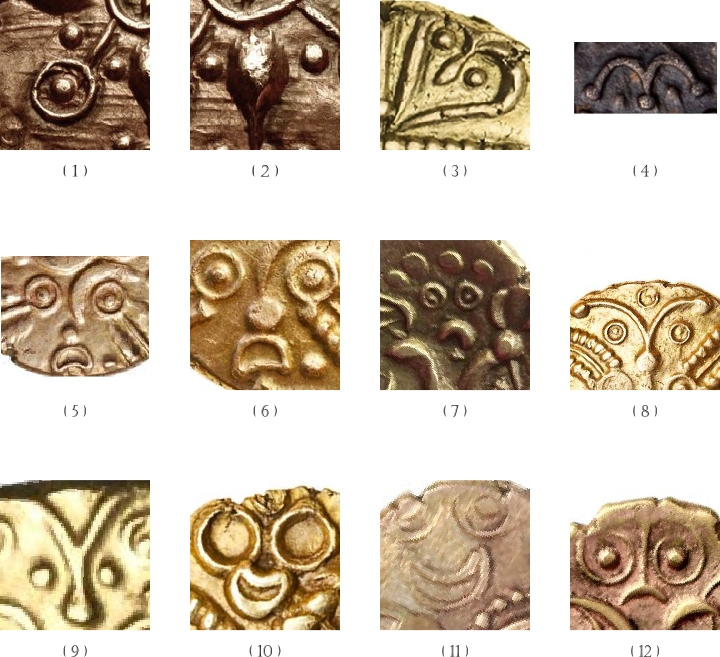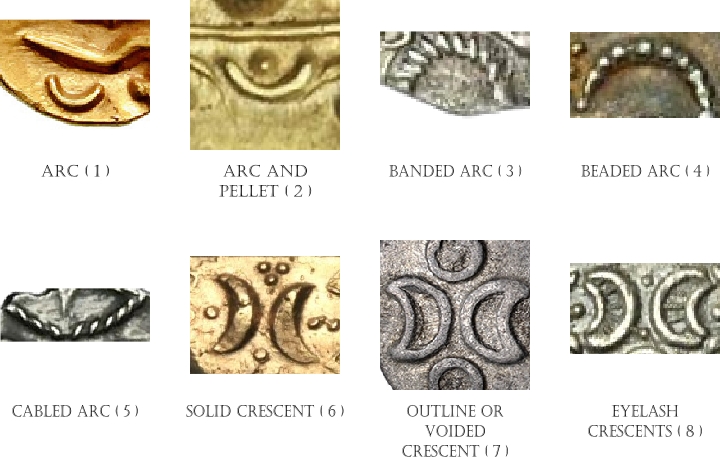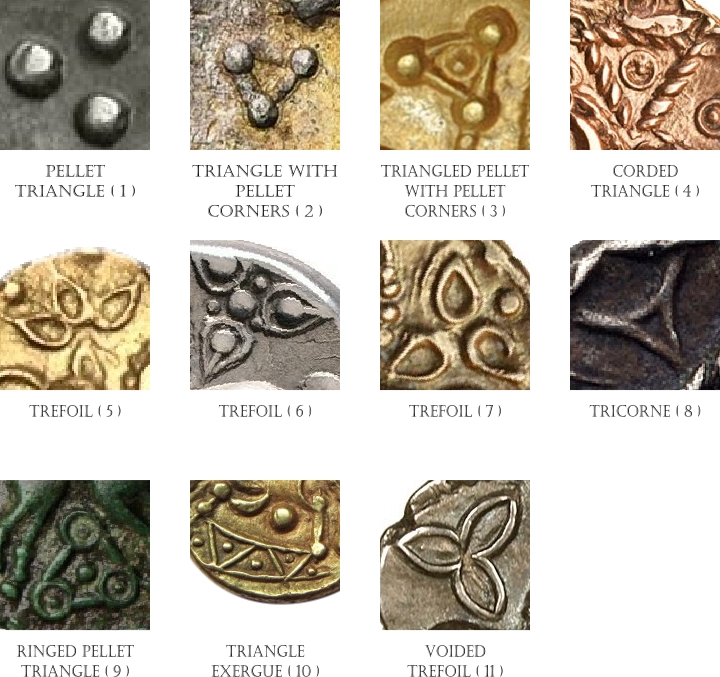| Back to Crude and Barbarous, or Just Different? | This page is part of the article Getting Started with Celtic Coins | Forward to What do They Mean? |
Describing the images on Celtic coins can be difficult due to their abstract nature. Many of the images appear to us now as random collections of shapes and motifs. Even where we can identify the major images on some coins, such as abstract renditions of horses or Apollo’s head, they tend to be accompanied by a selection of unknown shapes. If they ever had any meaning, it is lost to us now.
Photo Copyright Noble Numismatics Pty Ltd
That doesn’t stop people guessing of course, and we’ll look at that in the next section, but I’ll avoid speculation for now and just show you some of the most common symbols that appear. Knowing these can make it easier to compartmentalise the sometimes complex images, and at least describe what it is you are looking at. I’ve organised them into four top-level categories:
- People
- Animals
- Shaped and Objects
- Plants
People
Full Figures
Figures of people occur on some Celtic coins as the main image, but normally they are just part of a bigger picture. Some of the figures are remnants of the coins the Celts originally copied such as:
- The Charioteer from the Phillip II of Macedon Staters
- The Horse Rider from the Philip II of Macedon Tetradrachms
- Athena Alkis from the Antigonus II Gonatas tetradrachm
- Nike from the Alexander III stater
- Herakles from the Thasos Tetradrachms
- Athena and Nike from the Lysimachus stater
- Zeus from the Alexander III and Philip III Tetradrachms
Recognisable Full Figures
Miscellaneous Full Figures
Other figures, however, don’t have an obvious source:
Heads
Human heads normally form the main image on the obverse of a coin, but occasionally they can appear as elements alongside a main image.
Heads as the Main Image
Notes
- The head in image 6 is on the reverse of the coin. All the rest are on the obverse
Heads as Decorations
Hidden Faces
Hidden faces can be found on a number of Celtic coins from Britain. We’ll never know if they were deliberately made or just a side effect of the motifs used, but they are fun to look for and discover.
Animals
Horses
Horses are the most common reverse image on Celtic coins. Because the original Celtic coins were copies of Greek or Roman coins the early horses were realistic, but they became highly abstract as the Celts made the images their own. Towards the end of Celtic coinage, possibly because of Roman influence beginning to exert itself on the Celts, the horses started to become realistic again.
Horses as the Main Image
Horses as Decorations
Horses almost always appear as the main image on the reverse of a coin, but very occasionally they also appear as design elements making part of a larger image.
Boars
Boars are the second most common animal on Celtic coins, after the horse. They are common as the main design, on either the obverse or reverse, and are occasionally used as design elements in a larger design. They almost never appear on gold coins.
Boars as the Main Image
Boars as Decorations
Other Animals
Horses and boars weren’t the only animals that the Celts depicted on their coins, although they are by far-and-away the most common. Birds can also be found on a number of coins, either as main images or as decorations. Wolves make an occasional appearance, and other animals can sometimes be found, such as snakes, bulls, ox heads and bears.
Birds
Wolves
Snakes
Bulls
Oxen (Bucraniums)
Bears, Hares and Griffons
Shapes and Objects
There are a plethora of shapes and objects that appear on Celtic coins, especially the coins from Northern Gaul and Britain. Celtic art is characterised by a “Horror Vacui” – a fear of empty space. Their coins, before they became Romanised, are densely covered with symbols. The older Celtic coins from Eastern and North-Central Europe tended to be a bit more constrained in this respect. Symbols were used, but not with quite the same enthusiasm as in the later western coins.
I’ll cover the most common symbols here in alphabetical order. There are no standard names for these symbols, and sometimes the same author will use different names for the same shape.
Arcs and Crescents
Crescents and arcs are common decorations on Celtic coins. It is thought that they may have represented torcs and/or the moon, so will commonly be described as such. They are also an important element in creating hidden faces.
The names arc and crescent are sometimes used interchangeably, but technically an arc is a curved line and a crescent is an enclosed shape.
Coffee Beans
A “Coffee Bean” is an ellipse with either a pellet or another ellipse in the middle. They are sometimes described as “Vestigial Chariot Wheels” as they are so similar to the chariot wheels on the original Philippus, and are almost certainly the remnants of this:
Photo Copyright Leu Numismatik AG
Cogs
Cogs might seem to be a surprising symbol to appear on Celtic coins, but mechanical cogs were known and used in Celtic times. The Antikythera Mechanism was an analogue computer used for astronomical calculations such as predicting eclipses, and the positions of the sun and moon. It had thirty-seven cogs, and is thought to have been made sometime between 205 BC and 60 BC.
Normally described as sun symbols, it might be that cogs were added to coins as a nod towards cutting edge technology.
Crosses
Diamond Shapes
Diamond shapes are also called kites and lozenges.
Fibula
A fibula is a brooch used by the Greeks and Romans (and probably everyone else at the time) for fastening garments together. They are found on the obverse of some coins that were derived from the Gallo-Belgic A broad-flan stater.
Hairlocks
Hairlocks are normally found on the obverses of coins, and they are the remnants of the hairlocks on the Philip II stater that many of these coins were derived from. They sometimes get called “Bear Paws”, “Wolf Paws” or “Fish”.
Letter Shapes
A number of shapes that appear on Celtic coins resemble letters. These appear on unscribed coins, so are not thought to represent actual letters. It’s debatable whether the X shape should be here or in the Cross section. I’ve included it here if it looks like an X when the coin is in its natural orientation.
Lyre
Nets
Pellets and Rings
Pellets and rings are the basic building blocks of many symbols on Celtic coins. These two basic shapes were combined in many ways to create a large range of composite symbols. This section shows some of the simpler compositions.
While there are many possible interpretations for these composite symbols, from suns, stars, eyes, mint marks and other control marks, we can’t rule out the fact that they were common because they were one of the easiest shapes to carve into a die.
Spirals
Squares and Rectangles
Stars
Thunderbolt/Lightning-Flash
Torcs
Torcs are arcs with pellets on the ends. Torcs were popular with the Celts, but it’s not clear if all of these shapes were meant to be literal representations of them.
Triangles, Trefoils, and Tricorns
Wheels
Wheels are common on Celtic coins, partly because most Gaulish and British coins derived from the Philip II gold stater which had a wheeled chariot on it. The fact that the wheel survived but other aspects of the image didn’t suggests that the wheel had a deeper meaning to the Celts.
Wing
Wings on Celtic coins can be found on birds (obviously), horses, and occasionally people. On some of the winged horses, it’s not clear if the wing belongs to the horse, or if it represents a bird flying above the horse where the rider should be.
Plants
Flowers
Flowers on Celtic coins can be put into three categories:
- Flowers as a central part of a geometric pattern on the obverse of later British coins
- Flowers as design elements on the reverse of coins
- Flowers that look like the sun
Flowers in the first two of these categories are not common, and flowers in the third might not have been flowers.
Flowers as the main image
Flowers as design elements
Floral Suns
Leaves and Braches
Article Navigation
| Back to Crude and Barbarous, or Just Different? | Up to Art on Celtic Coins | Forward to What do They Mean? |












































